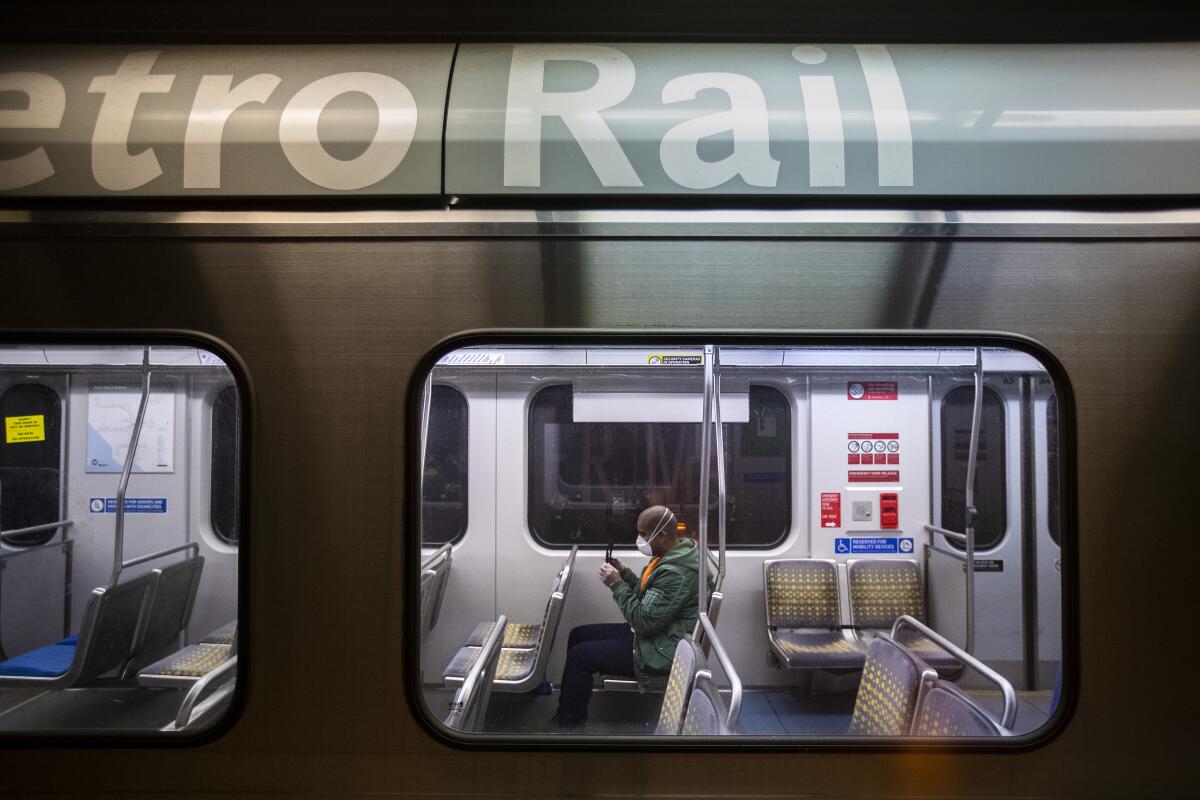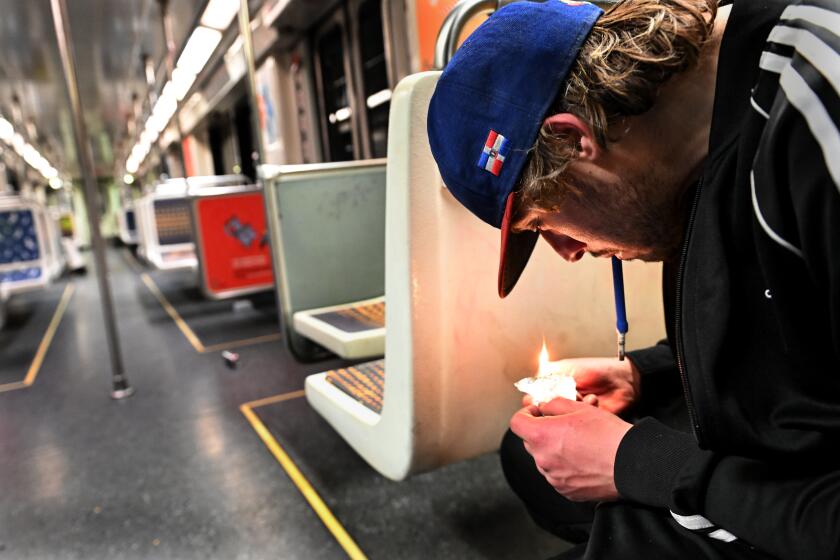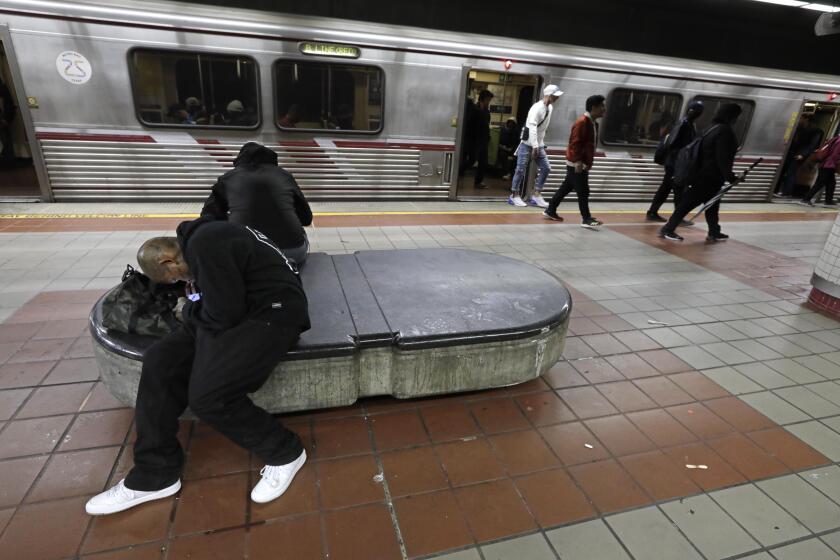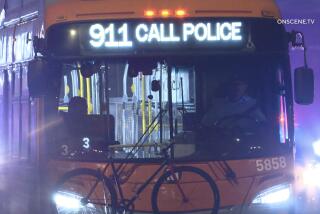Opinion: How can L.A. Metro make train service safer? Look to what’s working on buses

- Share via
Los Angeles Metro is taking steps to improve public transportation safety for riders. Transit agency officials are deploying more security and law enforcement, introducing transit ambassadors, promoting their Transit Watch app to report crimes, and playing music in stations to deter unwanted behaviors. However, these strategies may not be sufficient to address the growing violence and drug use on the system. Instead, L.A. Metro should look to its buses — where crime is significantly lower — for inspiration.
The types of crimes on transit are varied, from prohibited behaviors like smoking or drug use, vandalism or theft, to assaults and other violent crimes. In January 2023, train riders experienced roughly 7 crimes per 200,000 passengers, and bus riders experienced 1 crime for the same number of people. The bus system provided 16.4 million monthly trips and experienced 88 crimes. The rail system provided 2.2 million monthly trips, and passengers experienced 171 crimes.
Buses aren’t safer because their rubber tires act like crime-fighting vigilantes. The most likely explanation for why buses are safer is because more people use them.
Buses have always been the backbone of L.A.’s transit system, carrying four times more passengers than trains. The rebounds in ridership since the onset of the COVID-19 pandemic are a good example. Average weekday train ridership has yet to hit 50% of pre-pandemic levels, while the bus system has fared better, with 77% of those riders returning. Ridership and service levels are closely connected, so it’s no surprise that ridership gains have followed as L.A. Metro restored pre-pandemic bus service levels. In contrast, rail service (and ridership) levels remain lower than pre-COVID.
Commuters have abandoned large swaths of a Los Angeles Metro train system plagued by crime and the scourge of drugs.
Prioritizing bus service levels over rail is a notable departure from L.A. Metro’s focus on rail system expansion. L.A. Metro’s critics commonly decry rail system expansion because people who ride the train are more likely to be wealthier and white and have access to cars than those who use the bus system. On the other hand, bus riders tend to rely on public transit as their primary mode of transportation. They are L.A. Metro’s core customers, so it’s not surprising these passengers have returned.
As fewer people rode public transit — particularly the train system — social norms eroded. Behaviors changed from minor issues like passengers putting their feet on seats to more concerning behaviors like smoking cigarettes or openly using drugs. In January 2023, L.A. Metro reported 37 so-called crimes against society on the train, such as smoking or drug use, compared to 21 reports in January 2019.
The best way forward is to take lessons from the bus and get more people on board to enforce public transit’s social norms. These social norms and unspoken rules of engagement guide the public transit experience. Someone’s quiet, uneventful journey is often reinforced by other people doing the same, with an occasional moment of people coming together to help. Those moments like when a passenger is standing at the rear bus exit trying to leave, and a chorus of other passengers shouts “BACK DOOR” to make sure the driver can hear the request.
The good news is that L.A. Metro’s current budget proposal includes increasing rail service levels as soon as this summer. But how can a virtuous cycle begin where ridership comes back as service levels increase? One approach is focusing on rail riders who are not weekday commuters.
Researchers at Stanford University found that in 2023, workers spend an average of 1-2 days a week working from home. With fewer office workers making trips to the office, orienting transit service around traditional peak commuting patterns no longer makes sense. The fact that average Sunday bus ridership has seen 98% of ridership levels return is evidence of these shifting travel patterns. L.A. Metro should pay attention to increasing service for all weekend sporting events and concerts and show non-regular riders a high-quality weekend experience that may tempt their return to weekday trips.
The transportation authority’s goal with the classical music is to ‘to restore safety’ at the MacArthur Park station. The music is divisive, with online commentators calling it an inhumane torture tactic.
Another lesson from the bus is to activate areas where people wait. Bus stops have nearby stores, restaurants and pedestrians, all of which provide natural surveillance. Rail stations can feel empty and isolated. Allowing licensed street vendors to set up on station platforms is an opportunity to mimic street-level vibrancy. They could also provide tasty treats for people to enjoy when wait times are longer than expected.
Limits exist to make the train like a bus on steel tracks and get more people on board. Stations cannot move closer to people’s homes or destinations. Passengers cannot stand next to the train operator and chat if they feel unsafe. Sunshine isn’t an option below ground.
Whatever steps L.A. Metro takes to address crime should be good solutions for transit in general, not just for safety. Increasing train service levels will not solve our societal problems in Los Angeles. More service will not lower our population of people experiencing homelessness, nor will it take fentanyl out of communities. But increasing service can increase ridership, which has proved to reduce crime. The bus system’s relationship between more riders and less crime is proof positive. It’s time to stop looking for innovative or new solutions when the answer has been roaming the streets all along.
Madeline Brozen is deputy director of the UCLA Lewis Center for Regional Policy Studies.
More to Read
A cure for the common opinion
Get thought-provoking perspectives with our weekly newsletter.
You may occasionally receive promotional content from the Los Angeles Times.












